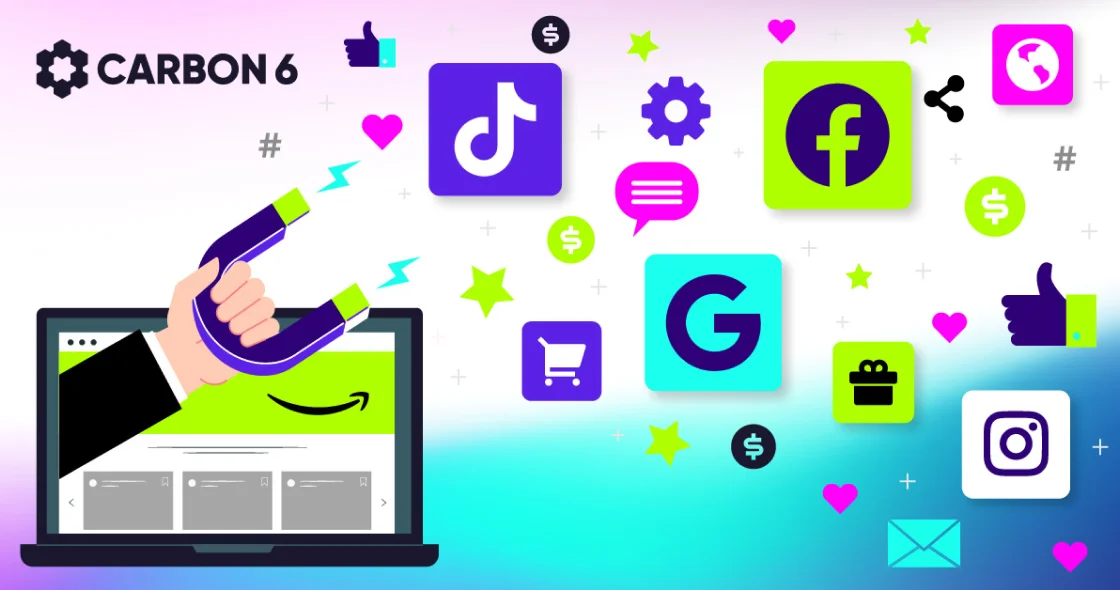Whether your brand is big or small, reaching as many potential buyers as an Amazon Seller should be the primary goal of your marketing strategy.
However, one thing sellers are realizing is that to increase sales velocity, to spread more brand awareness, to stand out from competition, and to increase a business’ profitability, it’s more critical than ever not just to cultivate traffic on Amazon, but to target potential customers off-Amazon, too.
The truth is, outside traffic can often be more effective than PPC campaigns for Amazon sellers. But what are the most effective ways to drive external traffic to your Amazon listings?
To help your business gain that extra edge, we’ve put together three proven strategies for bringing qualified off-Amazon traffic to your product detail page and storefront.
What Is Off-Amazon Traffic and Why Is It So Important?
“Off-Amazon” refers to any traffic that comes from outside of Amazon’s marketplace. But why has it become increasingly important for Amazon brands?
Leveraging outside traffic is a complementary piece to your Amazon PPC campaign strategies because it effectively boosts your keyword rank and sales velocity, and it helps brands scale.
External traffic helps you grow your own audiences, collect email addresses, and capture shoppers using pixels. So there’s a lot of value to focusing your efforts off the platform.
Many sellers have heard how much better organic traffic is compared to paid traffic when it comes to boosting any ranking on Amazon, but off-Amazon traffic is actually three times more effective than PPC in terms of product ranks and reviews.
Considering how much competition there is on Amazon, it makes sense why targeting this traffic is so important. Focusing an Amazon advertising strategy to capture Google Ads traffic, TikTok users, and other off-Amazon platforms can significantly expand a business’ footprint and separate Amazon Sellers from the competition, making other sellers less relevant.
Which Off-Amazon Audiences Should You Target – And How?

The question of which off-Amazon audiences FBA sellers should focus on targeting is perhaps best tempered with how to target those potential customers in a way that yields the most profitable results. But first, it’s best to get an idea of the three potential audience types to target:
- Cold audiences are targeted based on their Google search terms or demographics & interests. They may not have visited a site in the past, but the inclination to do so is inherent based on these shared interests.
- Warm audiences are those users who have engaged with an ad or visited a website from all platforms, and may do so again based on that behavior.
- Past customers are those who have purchased from a business in the past; this audience can be retargeted to introduce a new product to or remind them to buy again.
Even when sellers know the different levels of audience they’re dealing with off-Amazon, the question remains: How can you reach these vital audiences to win big?
How Amazon Sellers Can Use Google Ads
Amazon Sellers should target relevant keywords, demographics, and user interests using Google, TikTok, and Facebook ads. With Google, it’s important to figure out the best keywords to target. To do so, sellers must identify the highly-used search terms on Google that are most relevant to a brand or its products.
By using a platform like Google Ads to target related keywords, sellers can capture more Google shoppers who are in the market for items like theirs. Of course, it’s always best to target customers in the right frame of mind for conversion.
These Google users are actively seeking a solution to their problem, as opposed to browsing organic content on social media. This means they’re a bit closer to the point of sale. That’s what makes Google Ads such a great tactic, and it can be used as a remarketing tool, too.
Facebook and TikTok users are typically not using these platforms with the intention to shop, so Google is often the best place to start when you want to test external traffic to Amazon.
How Amazon Sellers Can Use Facebook & TikTok

Unlike Google Ads, a seller’s approach to reaching high-quality Facebook and TikTok users should be based on interests, demographics, and past behaviors – not search terms.
Instead, Amazon Sellers should leverage Facebook and TikTok to spread brand awareness, sharing their most engaging, viral product videos, and for retargeting campaigns.
But what is the best way to generate this type of content? One idea is connecting with and utilizing the advertising power of Influencers.
Influencers who are present and popular on social platforms can bring in far more off-Amazon traffic to listings and storefronts – and they can do it fast. But, are they really worth it?
Are Off-Amazon Influencers Worth It?
If you’ve been wondering whether you should explore influencer-marketing for your brand and if it’s worth it, our answer is a resounding “yes.” In our opinion, influencer partnerships are a modern trend that more Amazon sellers will continue to explore and leverage.
You can find these content creators on Instagram, YouTube, Facebook and even more platforms. Sellers can offer influencers Amazon Attribution as a form of payment, but there are also performance-based payment structures, fixed-rate, and pay-per-post or per creative payment structures, as well.
There is another type of influencer that might work best for your budget known as micro influencers. These entry-level influencers, if you will, may offer creative in exchange for free products because they’re still in the beginning stages of growing an audience.
In order to safeguard conversion rates and protect rankings, with or without influencers, Amazon sellers should also drive potential customers to a sales landing page before linking them directly to their Amazon product. This is a smart practice for any Amazon business strategy.
Any time a listing gets views that don’t convert, the conversion rate on Amazon drops, which negatively impacts ranking and visibility. If you’re reaching cold audiences who are not ready to buy, it’s best not to send them to your Amazon listing just yet.
On this landing page, make sure to promote products with compelling images, tons of social proof, and photos of customers holding your product. Get those testimonials and video reviews rolling in and featured on your sales page.
Take advantage of this autonomous space by including copy and imagery you can’t use on Amazon and make the most of it to capture more sales. Of course, you also want to link to your listings and storefront on this page so serious shoppers can click through and purchase.
The goal in doing so is to limit the number of clicks from “window shoppers,” so it’s key to remain transparent and honest about your product. Never overpromise, or you sacrifice your rating and reviews, as well as your ranking.
Amazon’s Brand Referral Bonus is a great way to save money on Amazon fees. According to Amazon, “For sellers enrolled in Amazon Brand Registry and selling in Amazon’s US store, Amazon’s Brand Referral Bonus is an opportunity to earn, on average, a 10% bonus of the sales price on sales generated from non-Amazon marketing efforts.”
Retargeting Is a Key Off-Amazon Strategy for Sellers
Retargeting refers to advertising to users who have already visited your website, engaged with an ad, or made a purchase. The best part about retargeting is that sellers have the ability to grow an existing customer list and can even capture an email address list, which is a game-changer for future promotions.
With these emails and audiences, you can reach those customers in your cross-selling campaigns when pitching similar, complementary, or even repeat consumable products.
What Is an FBA Seller’s Best Tool for Targeting Off-Amazon Traffic?

When investing in any external ads, always use a link attribution tool — they can be life-changing for sellers.
A tool like PixelMe will automatically include Amazon Attribution for Brand Referral Bonuses, and help improve a brand’s keyword ranking by building keywords into the URL. A tool like this also tracks individual influencer performance, as well as affiliate link data, allowing sellers to quickly analyze campaign performance and make data-driven decisions to increase profitability.
Make sure to provide separate links for each platform to completely isolate their individual performance measurements and make the most informed choices when deciding how to invest in various marketing efforts.
What Is the Future of Off-Amazon Traffic for Amazon Sellers?
Amazon rewards sellers who drive outside shoppers to its marketplace, and the e-commerce giant regularly offers third-party sellers more data and software opportunities.
It’s only a matter of time before Amazon and its partners roll out better attribution products and introduce new ways to easily drive and track external traffic back to its central storefront.
Relying only on Amazon traffic for sales and success leaves most potential buyers untapped. So sellers should make sure to start leveraging their brand’s potential now by exploring other platforms and external traffic sources.
If you’re an Amazon seller looking to capture off-Amazon traffic, Carbon6 can help simplify your success with PixelMe: the best way to optimize and automate your off-Amazon advertising.




